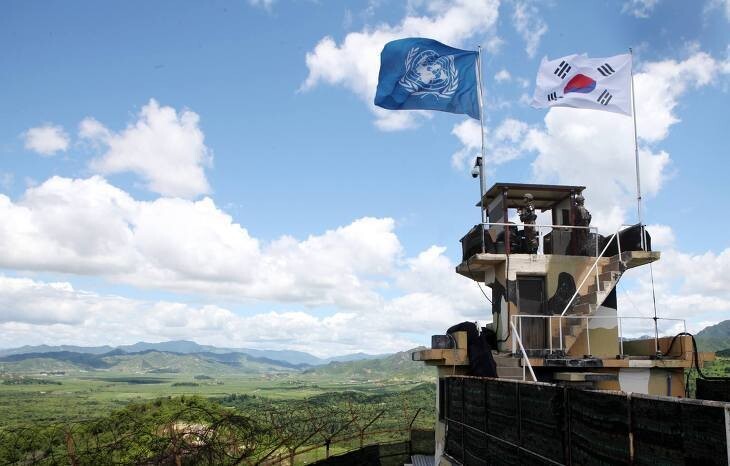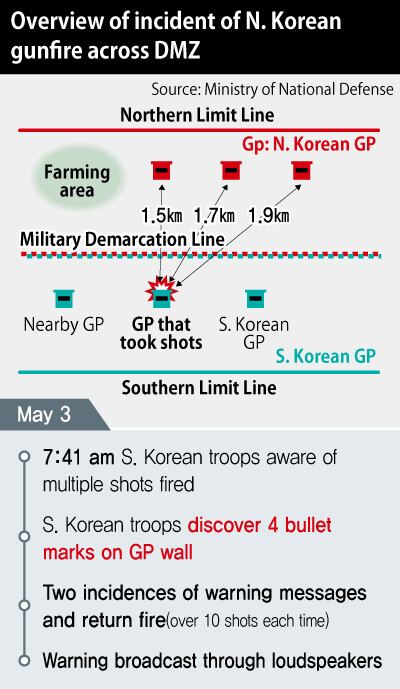hankyoreh
Links to other country sites 다른 나라 사이트 링크
[News analysis] N. Korea fires 4 shots across DMZ at S. Korean GP: provocation or accident?

On May 3, four bullets fired by North Korean troops struck the wall of a South Korean guard post in the DMZ. The incident prompted South Korea’s conservative politicians and press to criticize North Korea for failing to apologize after committing such a provocation. But South Korea’s military leaders have consistently maintained since the incident occurred that it was not a provocation but an accident.
Some observers have claimed that the gunshots were a deliberate provocation, since they occurred one day after North Korea’s state-run newspaper the Rodong Sinmun reported leader Kim Jong-un’s first public activity in 20 days. They also pointed out that the bullets were fired from a 14.5mm antiaircraft gun, the same weapon supposedly used to execute Jang Song-thaek, Kim’s uncle. (To be sure, the claim that Jang, former vice chairman of North Korea’s National Defense Commission, was shot to death by a 14.5mm antiaircraft gun has never been verified.)
When South Korean soldiers on duty at the guard post heard gunshots at 7:41 am on May 3, they immediately examined the surroundings and found four bullet holes in the external wall. South Korean forces returned fire by firing over 10 shots in two bursts then issuing a warning over the loudspeakers. While warning shots are typically fired into the air or into the ground at some distance from the target, the South Korean soldiers reportedly fired some of their bullets directly at the North Korean guard post, just as the North Koreans had done.

South Korea’s Joint Chiefs of Staff haven’t officially declared the incident to be either a provocation or an accident. That said, military officials have posited several reasons to think it was unintentional. For one thing, the South Korean guard post where the bullet holes were found was 1.5-1.9km away from the North Korean guard posts where the gunfire likely originated, exceeding the effective range (1.4km) of a 14.5mm antiaircraft gun. Considering that a weapon’s accuracy decreases proportionally to its distance from the target, the military authorities said North Korea would probably not have chosen to fire at a guard post that was outside the gun’s effective range.
Another reason to think the incident wasn’t deliberate is that the North Korean guard posts were lower in elevation than the South Korean guard post. Furthermore, the North would have been expected to respond to South Korea’s warning and return fire if the provocation had been deliberate, but it didn’t make a response. “If North Korea’s actions were deliberate, they would have responded to our gunfire or made some kind of reaction, but they didn’t do anything,” said an official from the South Korean government.
Other circumstances supporting this view are that there was thick fog in the area, making visibility very poor, around 1km; that the incident occurred after the North Korean soldiers on duty had been replaced and soldiers on the next shift were checking the weaponry; and that usual activities were underway at North Korean farms in the area.
US Secretary of State Mike Pompeo said on May 3 that the North Korean troops’ gunfire was “accidental,” indicating that the South Korean and US militaries have reached the same conclusion.
UN Command may say S. Korean response was excessiveOn May 4, the UN Command launched an on-site investigation of the incident. While the UN Command hasn’t released its findings yet, some military sources think it might actually take issue with the South Korean troops’ return fire. According to the South Korean military’s rules of engagement, return fire is supposed to be proportional, but the South Korean soldiers fired two bursts of over 10 shots, significantly more than the four shots fired by the North Korean troops.
“We’ll have to wait for the results, but I wouldn’t rule out the UN Command concluding that the South Korean troops took excessive action,” a source in the South Korean military said on May 5.
Another question is why the North Koreans haven’t offered an explanation about the gunfire. South Korea’s senior envoy to its general officer-level talks with the North asked for an explanation in a message delivered by telephone on May 3, but the North hasn’t responded.
In fact, it’s quite rare for North Korea to respond immediately to complaints by the South Korean authorities delivered over the telephone. The number of times the North Koreans have openly admitted wrongdoing or offered an explanation can be counted on two hands. Even then, the apology or explanation was usually forced by inter-Korean relations or political or diplomatic reasons, such as when the North expressed its “regret” during high-level talks with South Korea shortly after a landmine exploded in the DMZ in August 2015. The fact that relations between the South and North Korean authorities have been on hold since the rupture of talks in the North Korea-US summit in Hanoi in February 2019 is regarded as another reason why the North has been slow to offer an explanation.
By Noh Ji-won, staff reporter
Please direct comments or questions to [english@hani.co.kr]

Editorial・opinion
![[Column] The state is back — but is it in business? [Column] The state is back — but is it in business?](https://flexible.img.hani.co.kr/flexible/normal/500/300/imgdb/original/2024/0506/8217149564092725.jpg) [Column] The state is back — but is it in business?
[Column] The state is back — but is it in business?![[Column] Life on our Trisolaris [Column] Life on our Trisolaris](https://flexible.img.hani.co.kr/flexible/normal/500/300/imgdb/original/2024/0505/4817148682278544.jpg) [Column] Life on our Trisolaris
[Column] Life on our Trisolaris- [Editorial] Penalties for airing allegations against Korea’s first lady endanger free press
- [Editorial] Yoon must halt procurement of SM-3 interceptor missiles
- [Guest essay] Maybe Korea’s rapid population decline is an opportunity, not a crisis
- [Column] Can Yoon steer diplomacy with Russia, China back on track?
- [Column] Season 2 of special prosecutor probe may be coming to Korea soon
- [Column] Park Geun-hye déjà vu in Yoon Suk-yeol
- [Editorial] New weight of N. Korea’s nuclear threats makes dialogue all the more urgent
- [Guest essay] The real reason Korea’s new right wants to dub Rhee a founding father
Most viewed articles
- 1[Column] Why Korea’s hard right is fated to lose
- 260% of young Koreans see no need to have kids after marriage
- 3Amid US-China clash, Korea must remember its failures in the 19th century, advises scholar
- 4[Column] The state is back — but is it in business?
- 5Japan says it’s not pressuring Naver to sell Line, but Korean insiders say otherwise
- 6AI is catching up with humans at a ‘shocking’ rate
- 7S. Korean chaebols comprise 84% of GDP but only 10% of jobs
- 8Hybe-Ador dispute shines light on pervasive issues behind K-pop’s tidy facade
- 9[Column] Life on our Trisolaris
- 10[Reportage] New funeral culture taking hold in South Korea